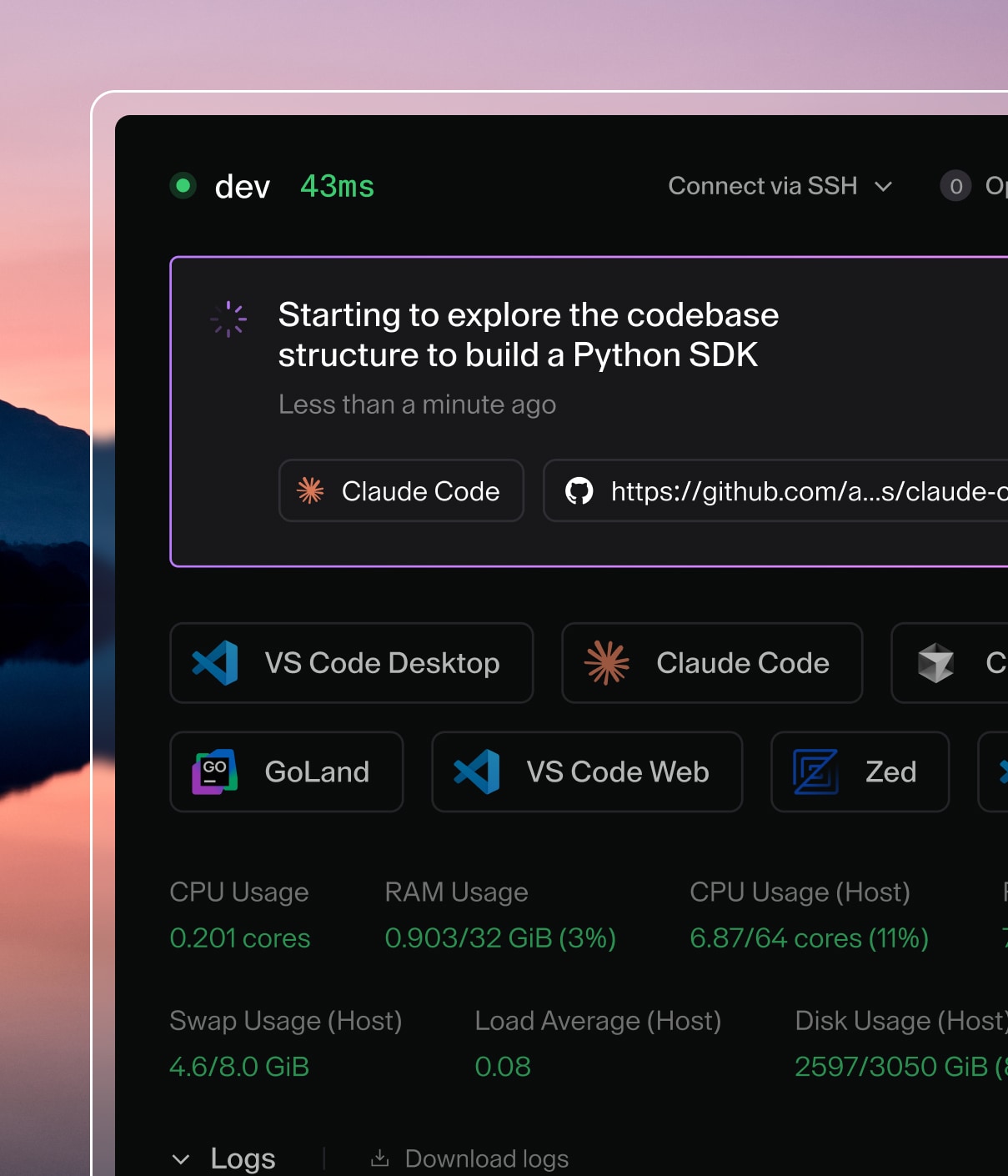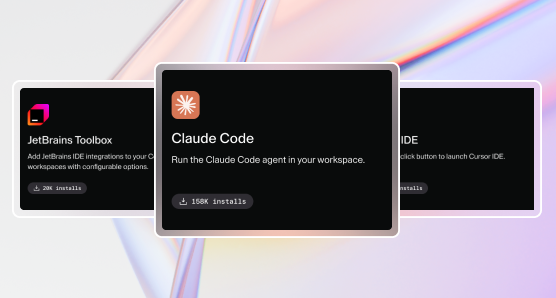Contributing
Requirements
-
After you've installed Nix, instantiate the development with the
nix-shellcommand:cd ~/code/coder # https://nix.dev/tutorials/declarative-and-reproducible-developer-environments nix-shell ... copying path '/nix/store/3ms6cs5210n8vfb5a7jkdvzrzdagqzbp-iana-etc-20210225' from 'https:// cache.nixos.org'... copying path '/nix/store/dxg5aijpyy36clz05wjsyk90gqcdzbam-iana-etc-20220520' from 'https:// cache.nixos.org'... copying path '/nix/store/v2gvj8whv241nj4lzha3flq8pnllcmvv-ignore-5.2.0.tgz' from 'https://cache. nixos.org'... ... -
Optional: If you have direnv installed with hooks configured, you can add
use nixto.envrcto automatically instantiate the development environment:cd ~/code/coder echo "use nix" >.envrc direnv allowNow, whenever you enter the project folder,
direnvwill prepare the environment for you:cd ~/code/coder direnv: loading ~/code/coder/.envrc direnv: using nix direnv: export +AR +AS +CC +CONFIG_SHELL +CXX +HOST_PATH +IN_NIX_SHELL +LD +NIX_BINTOOLS +NIX_BINTOOLS_WRAPPER_TARGET_HOST_x86_64_unknown_linux_gnu +NIX_BUILD_CORES +NIX_BUILD_TOP +NIX_CC +NIX_CC_WRAPPER_TARGET_HOST_x86_64_unknown_linux_gnu +NIX_CFLAGS_COMPILE +NIX_ENFORCE_NO_NATIVE +NIX_HARDENING_ENABLE +NIX_INDENT_MAKE +NIX_LDFLAGS +NIX_STORE +NM +NODE_PATH +OBJCOPY +OBJDUMP +RANLIB +READELF +SIZE +SOURCE_DATE_EPOCH +STRINGS +STRIP +TEMP +TEMPDIR +TMP +TMPDIR +XDG_DATA_DIRS +buildInputs +buildPhase +builder +cmakeFlags +configureFlags +depsBuildBuild +depsBuildBuildPropagated +depsBuildTarget +depsBuildTargetPropagated +depsHostHost +depsHostHostPropagated +depsTargetTarget +depsTargetTargetPropagated +doCheck +doInstallCheck +mesonFlags +name +nativeBuildInputs +out +outputs +patches +phases +propagatedBuildInputs +propagatedNativeBuildInputs +shell +shellHook +stdenv +strictDeps +system ~PATH 🎉- If you encounter a
creating directoryerror on macOS, check the troubleshooting section below.
- If you encounter a
Development workflow
Use the following make commands and scripts in development:
./scripts/develop.shruns the frontend and backend development servermake buildcompiles binaries and release packagesmake installinstalls binaries to$GOPATH/binmake test
Running Coder on development mode
-
Run the development script to spin up the local environment:
./scripts/develop.shThis will start two processes:
- http://localhost:3000 — the backend API server. Primarily used for backend development and also serves the static frontend build.
- http://localhost:8080 — the Node.js frontend development server. Supports hot reloading and is useful if you're working on the frontend as well.
Additionally, it starts a local PostgreSQL instance, creates both an admin and a member user account, and installs a default Docker-based template.
-
Verify Your Session
Confirm that you're logged in by running:
./scripts/coder-dev.sh listThis should return an empty list of workspaces. If you encounter an error, review the output from the develop.sh script for issues.
Note
coder-dev.shis a helper script that behaves like the regular coder CLI, but uses the binary built from your local source and shares the same configuration directory set up bydevelop.sh. This ensures your local changes are reflected when testing.The default user is
[email protected]and the default password isSomeSecurePassword! -
Create Your First Workspace
A template named
dockeris created automatically. To spin up a workspace quickly, use:./scripts/coder-dev.sh create my-workspace -t docker
Deploying a PR
You need to be a member or collaborator of the coder GitHub organization to be able to deploy a PR.
You can test your changes by creating a PR deployment. There are two ways to do this:
-
Run
./scripts/deploy-pr.sh -
Manually trigger the
pr-deploy.yamlGitHub Action workflow:
Available options
-dor--deploy, force deploys the PR by deleting the existing deployment.-bor--build, force builds the Docker image. (generally not needed as we are intelligently checking if the image needs to be built)-e EXPERIMENT1,EXPERIMENT2or--experiments EXPERIMENT1,EXPERIMENT2, will enable the specified experiments. (defaults to*)-nor--dry-runwill display the context without deployment. e.g., branch name and PR number, etc.-yor--yes, will skip the CLI confirmation prompt.
Note
PR deployment will be re-deployed automatically when the PR is updated. It will use the last values automatically for redeployment.
Once the deployment is finished, a unique link and credentials will be posted in the #pr-deployments Slack channel.
Styling
Pull Requests
We welcome pull requests (PRs) from community members including (but not limited to) open source users, enthusiasts, and enterprise customers.
We will ask that you sign a Contributor License Agreement before we accept any contributions into our repo.
Please keep PRs small and self-contained. This allows code reviewers (see below) to focus and fully understand the PR. A good rule of thumb is less than 1000 lines changed. (One exception is a mechanistic refactor, like renaming, that is conceptually trivial but might have a large line count.)
If your intended feature or refactor will be larger than this:
- Open an issue explaining what you intend to build, how it will work, and that you are volunteering to do the development. Include
@coder/community-triagein the body. - Give the maintainers a chance to respond. Changes to the visual, interaction, or software design are easier to adjust before you start laying down code.
- Break your work up into a series of smaller PRs.
Stacking tools like Graphite are useful for keeping a series of PRs that build on each other up to date as they are reviewed and merged.
Each PR:
- Must individually build and pass all tests, including formatting and linting.
- Must not introduce regressions or backward-compatibility issues, even if a subsequent PR in your series would resolve the issue.
- Should be a conceptually coherent change set.
In practice, many of these smaller PRs will be invisible to end users, and that is ok. For example, you might introduce a new Go package that implements the core business logic of a feature in one PR, but only later actually "wire it up" to a new API route in a later PR. Or, you might implement a new React component in one PR, and only in a later PR place it on a page.
Reviews
The following information has been borrowed from Go's review philosophy.
Coder values thorough reviews. For each review comment that you receive, please "close" it by implementing the suggestion or providing an explanation on why the suggestion isn't the best option. Be sure to do this for each comment; you can click Done to indicate that you've implemented the suggestion, or you can add a comment explaining why you aren't implementing the suggestion (or what you chose to implement instead).
It is perfectly normal for changes to go through several rounds of reviews, with one or more reviewers making new comments every time, then waiting for an updated change before reviewing again. All contributors, including those from maintainers, are subject to the same review cycle; this process is not meant to be applied selectively or to discourage anyone from contributing.
Releases
Coder releases are initiated via
./scripts/release.sh
and automated via GitHub Actions. Specifically, the
release.yaml
workflow. They are created based on the current
main branch.
The release notes for a release are automatically generated from commit titles
and metadata from PRs that are merged into main.
Creating a release
The creation of a release is initiated via
./scripts/release.sh.
This script will show a preview of the release that will be created, and if you
choose to continue, create and push the tag which will trigger the creation of
the release via GitHub Actions.
See ./scripts/release.sh --help for more information.
Creating a release (via workflow dispatch)
Typically the workflow dispatch is only used to test (dry-run) a release, meaning no actual release will take place. The workflow can be dispatched manually from Actions: Release. Simply press "Run workflow" and choose dry-run.
If a release has failed after the tag has been created and pushed, it can be retried by again, pressing "Run workflow", changing "Use workflow from" from "Branch: main" to "Tag: vX.X.X" and not selecting dry-run.
Commit messages
Commit messages should follow the Conventional Commits 1.0.0 specification.
Allowed commit types (feat, fix, etc.) are listed in
conventional-commit-types.
Note that these types are also used to automatically sort and organize the
release notes.
A good commit message title uses the imperative, present tense and is ~50 characters long (no more than 72).
Examples:
- Good:
feat(api): add feature X - Bad:
feat(api): added feature X(past tense)
A good rule of thumb for writing good commit messages is to recite: If applied, this commit will ....
Note: We lint PR titles to ensure they follow the Conventional Commits specification, however, it's still possible to merge PRs on GitHub with a badly formatted title. Take care when merging single-commit PRs as GitHub may prefer to use the original commit title instead of the PR title.
Breaking changes
Breaking changes can be triggered in two ways:
- Add
!to the commit message title, e.g.feat(api)!: remove deprecated endpoint /test - Add the
release/breakinglabel to a PR that has, or will be, merged intomain.
Generative AI
Using AI to help with contributions is acceptable, but only if the AI Contribution Guidelines are followed. If most of your PR was generated by AI, please read and comply with these rules before submitting.
Security
Caution
If you find a vulnerability, DO NOT FILE AN ISSUE. Instead, send an email to [email protected].
The
security
label can be added to PRs that have, or will be, merged into main. Doing so
will make sure the change stands out in the release notes.
Experimental
The
release/experimental
label can be used to move the note to the bottom of the release notes under a
separate title.
Troubleshooting
Nix on macOS: error: creating directory
On macOS, a direnv bug can cause
nix-shell to fail to build or run coder. If you encounter
error: creating directory when you attempt to run, build, or test, add a
mkdir line to your .envrc:
use nix
mkdir -p "$TMPDIR"


